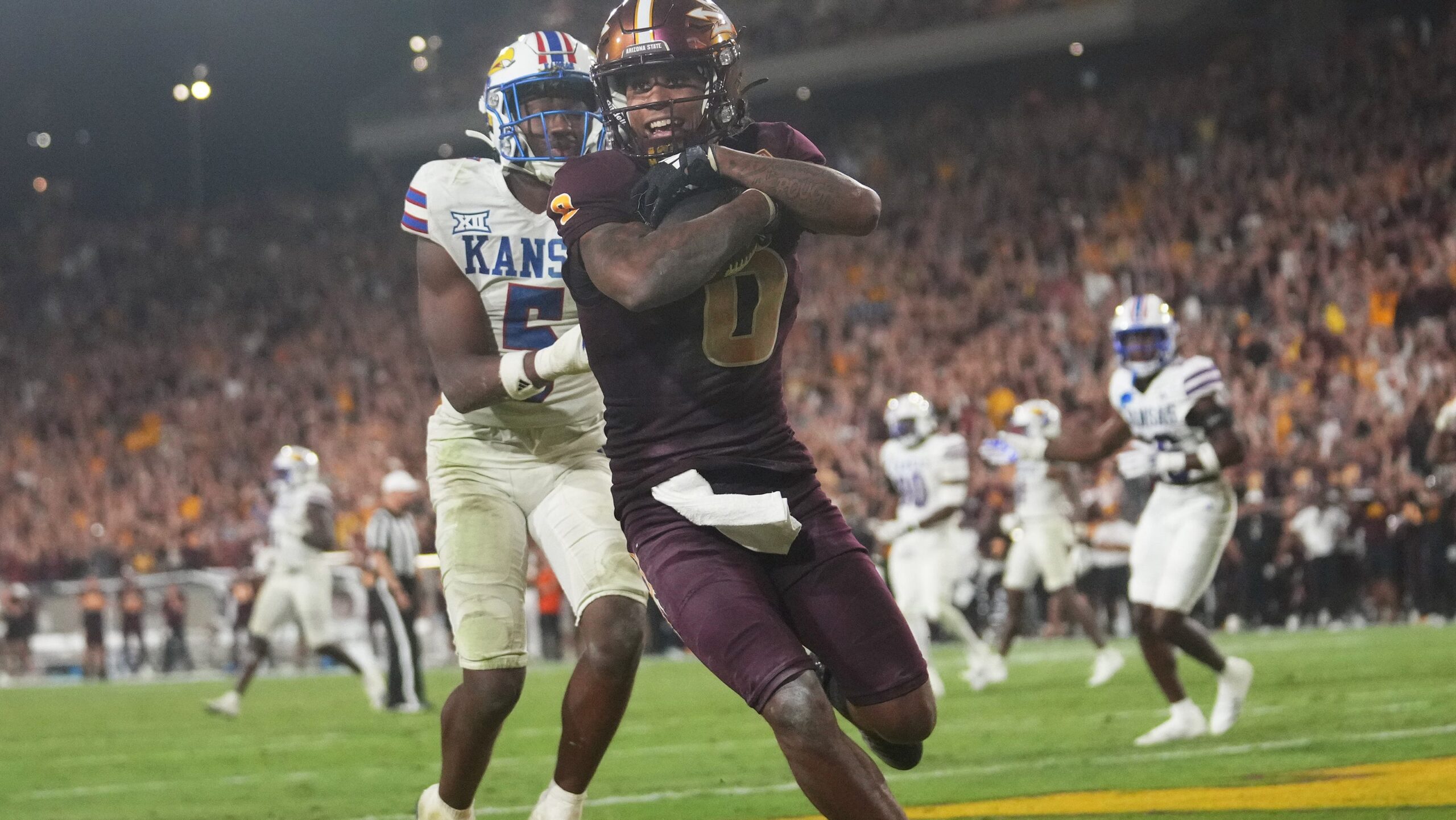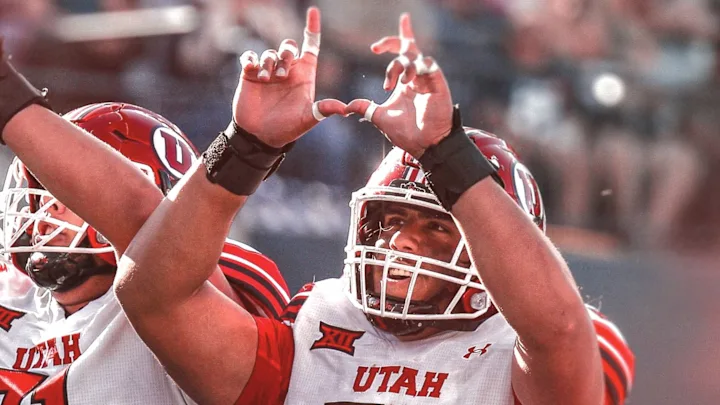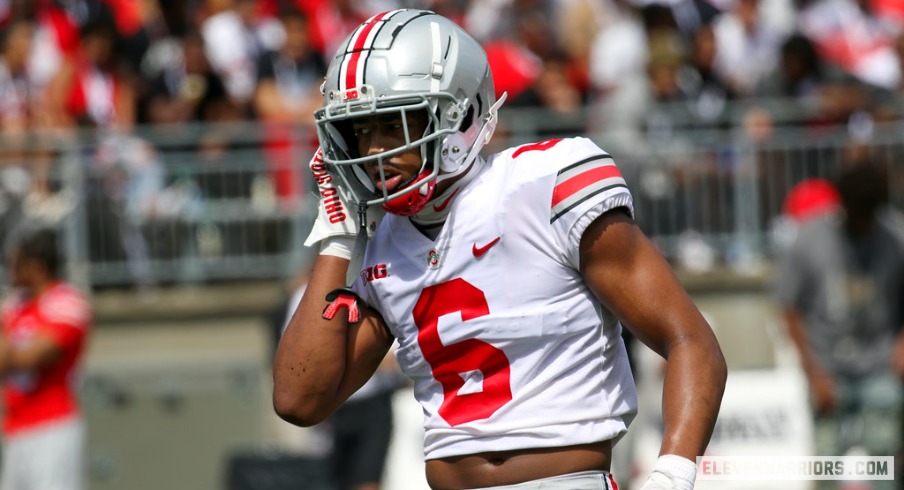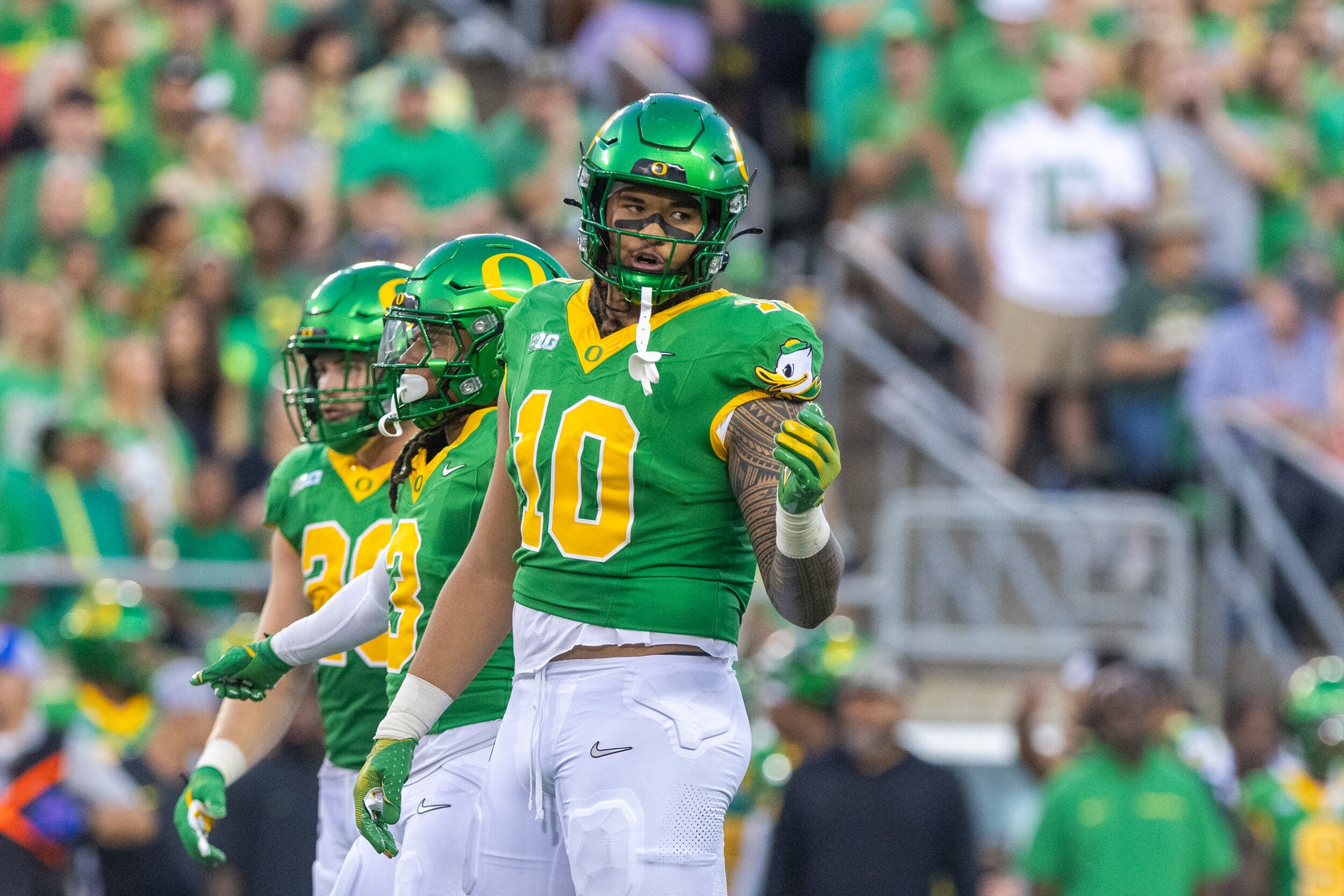By Charlie Campbell.
Send Charlie an e-mail here: [email protected]
Follow Charlie on Twitter @draftcampbell for updates.
This page was last updated March 30, 2023. Follow me @walterfootball for updates.
Wide Receiver Class
Early-round talent: C-
Mid-round: D+
Late-round: C
Overall grade: C-
Merging the 2023 and 2022 prospects
Drake London
Garrett Wilson
Chris Olave
Jameson Williams
Quentin Johnston
Jaxon Smith-Njigba
Jahan Dotson
Treylon Burks
Christian Watson
Jordan Addison
Wan’Dale Robinson
Zay Flowers
Jalin Hyatt
Cedric Tillman
Jonathan Mingo
Kayshon Boutte
Just to be clear, this article and series is all my opinion based off my own study and information I’ve gotten from general managers, directors of college scouting, national scouts, area scouts, and NFL coaches who know way more than I do.
Last year’s class of wide receivers was phenomenal. There was excellent talent for the first round of the draft, and there were wideouts who went in Rounds 2 and 3 who would have gone a round higher in a typical year. After a string of good years at wide receiver, the NFL was due for a less-talented class, and that has happened for the 2023 NFL Draft. The 2023 class is not as good in the early rounds, second day, mid rounds, and late rounds as last year or the year before.
If you were to merge the two classes together, Drake London, Garrett Wilson, Chris Olave and Jameson Williams would be better prospects than Quentin Johnston who is likely the top receiver for the 2023 NFL Draft. However, Johnston and Smith-Njigba are better prospects than Jahan Dotson was a year ago. Jordan Addison will probably go higher than Christian Watson did in 2022, but I personally think Watson was a better prospect. Zay Flowers is on a par with Wan’Dale Robinson, but the rest of the 2023 group is definitely behind Robinson.
Safest Pick: Quentin Johnston, TCU

Previous Picks:
2022: Drake London
2021: Ja’Marr Chase
2020: Jerry Jeudy
2019: Deebo Samuel
2018: Christian Kirk
2017: Corey Davis
2016: Will Fuller
2015: Amari Cooper
2014: Sammy Watkins
2013: DeAndre Hopkins
This was not an easy choice, but I think Johnston will translate best to the NFL because he has a massive frame, good speed, and dangerous run-after-the-catch ability. Johnston brings mismatch size, quality route-running, and natural receiving skills. He could be a very good pro wide receiver.
Biggest Bust Potential: Jalin Hyatt, Tennessee

Previous Picks:
2022: David Bell
2021: Elijah Moore
2020: Denzel Mims
2019: N’Keal Harry
2018: Auden Tate
2017: Curtis Samuel
2016: Corey Coleman
2015: Devin Funchess
2014: Kelvin Benjamin
2013: Cordarrelle Patterson
Some analysts are projecting Hyatt to be a first-round pick, and I think that could be a dangerous selection. Hyatt is a one-trick pony speed receiver who was also 1-year wonder in college. He could end up selected in the first round of the 2023 NFL Draft because of the weak receiver class, but Hyatt is really a third-round talent, according to multiple team sources. Of the wide receivers who could go early in the 2023 NFL Draft, Hyatt looks like he has the most bust potential.
Wide Receiver Rankings by Attributes
Separation:
NFL prototype: Ja’Marr Chase, Bengals
- Jaxon Smith-Njigba
- Jordan Addison
- Zay Flowers
- Quentin Johnston
- Jalin Hyatt
- Jonathan Mingo
- Kayshon Boutte
- Cedric Tillman
Recap: A few wide receivers coaches have told WalterFootball.com that the ability to separate from coverage is the first trait they looked for in scouting draft prospects. Smith-Njigba is the best in this draft class at creating space from defensive backs. He does it with good speed, quick feet, fast route-running, and suddenness out of his breaks. Smith-Njigba’s separation skills are one of his best traits.
Addison and Flowers are fast receivers who can separate from defensive backs based on pure foot speed. They are tough for defensive backs to run with and are able to generate space running vertically or crossing the field. Both are dynamic playmakers who present a threat to break wide open deep down the field on any given snap.
Both Johnston and Hyatt are threats to blow by defensive backs on any snap. They are explosive wideouts who can run past defensive backs and are dangerous at running go routes. Johnston is better at getting open a variety of routes, which gives him an edge over Hyatt.
Mingo can create separation by using his quickness to running routes downfield or across the middle. While he is not an ultra-fast explosive wideout like Smith-Njigba or Addison, Mingo has enough quickness to get open. Mingo proved his speed at the Senior Bowl and combine.
Boutte and Tillman could have issues generating consistent separation from some NFL cornerbacks. Neither one is game-breaking fast, but each has enough quickness to get downfield and can find just enough separation to use ball skills to make game-changing receptions.
Hands:
NFL prototype: DeAndre Hopkins, Cardinals
- Jaxon Smith-Njigba
- Jonathan Mingo
- Cedric Tillman
- Jordan Addison
- Zay Flowers
- Jalin Hyatt
- Quentin Johnston
- Kayshon Boutte
Recap: The 2023 NFL Draft features a nice crop of sure-handed receivers. Smith-Njigba has good hands and would rarely drop a pass. He attacks the football with his hands and really snatches it out of the air. Mingo and Tillman have hands that are effortless and natural. Addison and Flowers possess strong hands for smaller receivers.
Hyatt’s hands are just average. Johnston had some drops last year, but he displayed steady hands in other stretches, so he could develop into a sure-handed wideout with practice and coaching. Boutte had some ugly dropped passes in 2022, and he needs to improve his hands for the NFL.
Deep Speed:
NFL prototype: Tyreek Hill, Dolphins
- Jaxon Smith-Njigba
- Jordan Addison
- Zay Flowers
- Quentin Johnston
- Jalin Hyatt
- Kayshon Boutte
- Cedric Tillman
- Jonathan Mingo
Recap: There are a number of receivers in this group who have the ability to stretch the field vertically. Smith-Njigba, Addison and Flowers are legit deep-threat receivers with dangerous speed. They are very fast wideouts who can take a top off of a defense. Deep speed is one of the special dimensions each of the three brings to the table.
Johnston and Hyatt are dangerous deep-threat receivers for the NFL, and they both showed that ability over the course of their college careers. Both of them are capable of running past defensive backs to get open in the deep part of the field.
Boutte is a not a deep-speed receiver who burns defenses with pure explosion, but he can make some plays downfield. He has quickness and shiftiness. Tillman and Mingo are not burners for the NFL, but they have enough speed to get downfield and then will use their mismatch size along the sideline to threaten to produce some big plays with catches over defensive backs.
Route-Running:
NFL prototype: Stefon Diggs, Bills
- Jordan Addison
- Jaxon Smith-Njigba
- Zay Flowers
- Quentin Johnston
- Jonathan Mingo
- Cedric Tillman
- Jalin Hyatt
- Kayshon Boutte
Recap: Route-running is a critical part of gaining separation in the NFL. Receivers who get sloppy in their routes have a hard time getting open. Extra steps allow defensive backs to maintain coverage or more time to recover. All eight wideouts in this group are quality route-runners, and one of the best route-runners in this draft class is Kentucky wide receiver Jordan Addison.
Over the past two seasons, Addison showed he is a very polished receiver with advanced route-running. His route-running is first thing that stands out on tape. Addison is a smooth route-runner with quick feet who does not take extra steps or round off his cuts. He also shows some juice out of breaks, letting him dart past defenders to gain separation. Addison utilized superb route-running to get open for Kenny Pickett in 2021, and Addison continued to do the same in 2022 for USC.
Smith-Njigba is a phenomenal route-runner and is very polished entering the NFL. He is smooth and sudden in and out of his breaks, having speed and not taking extra steps. His route-running often produces immediate separation from cornerbacks.
Flowers and Johnston are plus route-runners. With his explosive speed, Flowers is a serious weapon. His speed allows him to quickly get open in the short to intermediate part of the field. He does a nice job of running downfield routes and shows suddenness out of his breaks. Johnston is a smooth route-runner who is good at slants, crosses, outs, and digs.
Mingo shows quality technique as a route-runner, and he has been coached up well. He doesn’t take false steps and runs crisp routes. Tillman is quick enough, and his size allows him to present a good target on short to intermediate routes. For a big receivers, Mingo and Tillman are both better route-runners than one would expect.
Hyatt needs coaching on the route tree and improvement in running a variety of routes. Boutte displayed some lazy route-running in 2022, and that will have to change drastically in the NFL.
Yards After the Catch:
NFL prototype: Deebo Samuel, 49ers
- Jordan Addison
- Zay Flowers
- Quentin Johnston
- Jonathan Mingo
- Kayshon Boutte
- Cedric Tillman
- Jaxon Smith-Njigba
- Jalin Hyatt
Recap: The ability to turn a short reception into a big gain can make a receiver elite. Among the eight receivers above, all of them have some run-after-the-catch ability. I wouldn’t say there is one who is really bad.
Addison and Flowers are shifty runners after the catch. Johnston and Mingo have some moves, plus they have size that makes them tough to tackle downfield. Boutte and Tillman show the ability to run for yards after the catch.
While he is a little linear and straight line, Smith-Njigba still has some yards-after-the-catch ability because he can dart past defenders for extra gains. Hyatt is a linear speed receiver after the catch.
Red Zone:
NFL prototype: Davante Adams, Raiders
- Quentin Johnston
- Cedric Tillman
- Jonathan Mingo
- Jaxon Smith-Njigba
- Kayshon Boutte
- Jordan Addison
- Zay Flowers
- Jalin Hyatt
Recap: This was a tough category to rank because so many of the receivers were excellent point producers in college. Johnston projects to being the best red-zone weapon of the group becaise he is the biggest of these receivers and is dangerous at winning 50-50 passes. On top of being able to sky over defenders for scores, Johnston can make easy catches and then use his running ability to go through defenders to cross the goal line.
Tillman could be very good in the red zone, and he recorded 12 touchdowns in 2021. He is a dangerous red-zone threat given his run-after-the-catch talent, leaping ability, and skill at winning on 50-50 passes.
Smith-Njigba has enough size, and his speed helps him to uncover quickly. He should be a good red-zone option as a pro. Mingo could be a good red-zone weapon in the NFL thanks to his size and toughness. He can win contested catches and is physical after the catch.
Boutte, Addison and Flowers all have some red-zone potential with their ability to get open quickly. Hyatt was more of a vertical receiver in college,so he will need development as a red-zone weapon.
NFL Picks - Dec. 13
NFL Power Rankings - Dec. 10
2026 NFL Mock Draft - Dec. 10
Fantasy Football Rankings - Sept. 1




